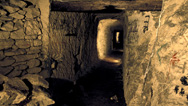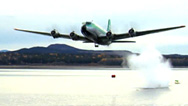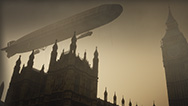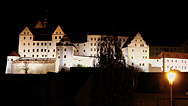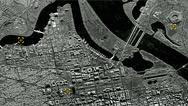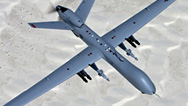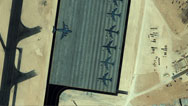
3D Spies of WWII
With 3D graphics, NOVA reveals how the Allies used special aerial photos to deal a dire blow to the Nazi rocket program. Airing July 24, 2013 at 9 pm on PBS Aired July 24, 2013 on PBS
- Originally aired 01.18.12
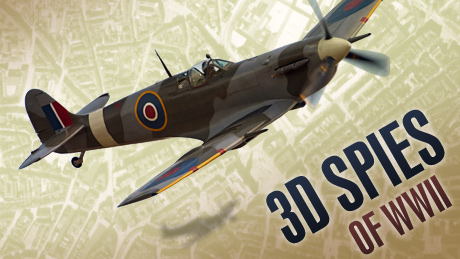
Program Description
Transcript
3D SPIES OF WWII
PBS Airdate: January 18, 2012
NARRATOR: It's the early days of World War II. Hitler's armies storm through Europe, crushing everything in their path. Western Europe is on the brink of defeat.
The allies turn to the iconic Spitfire to help change the course of the war. Now, the fighter plane is not armed with weapons that kill, but with one that will keep them one step ahead of the Nazi war machine: a surveillance camera. British and American pilots fly dangerous missions to gather critical intelligence.
JOHN S. BLYTH (Reconnaissance Pilot): My job was as a photo reconnaissance pilot. It was a wonderful airplane to fly. I loved it. It had cameras, no guns.
NARRATOR: In a country house, located 35 miles west of London, a team of brilliant minds analyzes the tens of millions of aerial photos taken during the war and recently declassified for the first time.
MIKE MOCKFORD (Royal Air Force Wing Commander, Retired): Nothing moved in Europe which we did not photograph, and it was utterly critical to the Allied success in the Second World War.
NARRATOR: The photo interpreters have a secret weapon to expose German secrets. Using stereoscopes, they bring the Nazi's world to life in 3D.
DINO BRUGIONI (Senior C.I.A. Analyst, Retired): In 3D, the first thing…you can get height, and also, at the same time, you can measure very effectively, too, the width.
NARRATOR: Using this technology, an obscure photograph reveals evidence of one of Hitler's most secretive and most lethal weapons programs.
MIKE MOCKFORD: In today's terminology, the V weapons were the first weapons of mass destruction.
NARRATOR: How did a handful of photo interpreters, so far from the battlefields, succeed in derailing Hitler's wonder weapons?
DINO BRUGIONI: Working night and day, they saved thousands and thousands of lives.
NARRATOR: 3D Spies of WWII, right now on NOVA. September, 1939: Germany invades Poland and the Second World War is under way. Adolf Hitler launches an all-out assault; one European nation after another crumbles.
JOE MAIOLO (Historian, King's College London): The German strategy was to win as quick a war as they possibly could.
NARRATOR: Britain is the last nation standing. Just eight months after invading Poland, Hitler is poised for domination. The battle for Europe unfolds in the skies over Britain. Defeating German airpower falls to Britain's most advanced fighter plane, the Spitfire.
JOHN BLYTH: When I was in high school, the Battle of Britain was on, and the Spitfire was the only aircraft that actually could compete against the Germans.
NARRATOR: Nearly four months later, the Spitfire and her heroic pilots helped to win the Battle of Britain. But the victory is short lived. The Germans begin a relentless nine-month bombing campaign against British cities. The Blitz leaves more than 40,000 civilians dead. To strike back at German cities, the Royal Air Force needs more accurate and up-to-date intelligence; aerial photographs are the key.
COLONEL ROBERT S. EHLERS (Historian, Angelo State University): Photographic reconnaissance was exceptionally important. Eighty percent of British intelligence came from photo interpretation. It allowed operational commanders to point their heavy bombers at the right targets.
NARRATOR: Once again, military leaders turn to the Spitfire. Now it will be armed, not with guns, but with cameras. The Spitfire is transformed from a killing machine into a spy plane, the Allies' eyes in the sky. It is re-designed to fly faster, higher and farther. Retrofitting the Spitfires with the new cameras is not a simple task.
JIMMY TAYLOR (Reconnaissance Pilot): It had five cameras. One was fitted under each wing, here, and two in the fuselage. And these were vertical cameras, and the big ones were for the high level, of course, and the small ones were for the low level.
NARRATOR: The F-52 camera, the most sophisticated of the day, is the weapon of choice. With its large image format and lenses with longer focal lengths, it can take detailed photos, like these, from altitudes of up to 30,000 feet.
JIMMY TAYLOR: The camera's here—as you can see, it's a pretty big one—and that would have to be put through this hatch here and point down, through one of these two port holes, in the bottom of the fuselage.
NARRATOR: The missions take pilots deep into German territory. There is a constant fear of being intercepted and shot down, and at 30,000 feet, temperatures plummet to minus-50 degrees.
JOHN BLYTH: It was cold. They bled off most of the warm air to heat the cameras, to keep the film going. Sometimes your knees…you could hardly bend them or anything.
NARRATOR: Taking photos that are useful to intelligence analysts requires extraordinary skill.
GEOFFREY STONE (Photo Interpreter, Royal Air Force, Medmenham): When they found their target, they had to fly a level course, because if they weren't flying straight and level, it distorted the pictures.
JOHN BLYTH: You would have to get right over the target, practically, and roll over and then see the target and bring the airplane around and level out, and then fly straight and level, while the cameras were turning.
NARRATOR: Reconnaissance pilots take tens of millions of photographs during the war. Many, only recently declassified, are kept here, at an archive in Edinburgh, Scotland. Researcher Allan Williams is working with retired R.A.F. Wing Commander Mike Mockford and Major Chris Halsall, both photo interpreters after the war, to track down the photos that helped defeat the Nazis.
MIKE MOCKFORD: Nothing moved in Europe which we did not photograph, and it was critical to the Allied success in the Second World War.
CHRIS HALSALL (Intelligence Corps Officer, Retired): Without air reconnaissance, it is difficult to imagine how we could have possibly achieved the results we did.
NARRATOR: The key to their success lies in a meticulous three-phase interpretation process that starts at the airfield.
JIMMY TAYLOR: They would look at the photographs and if something needed immediate action, within 24 hours, say, where the army had to shell or the air force had to bomb some target.
NARRATOR: The photos were then rushed to an air force base at Medmenham, a country estate, 35 miles west of London.
JIMMY TAYLOR: They'd send all the more important photographs to Medmenham, because they had interpreters there. And there were 2,000 of these by the war's end, all specialized in different sections. And they would then identify whether there was something that could be bombed or attacked in the next week or so, which was phase two, or whether it was long term thing about the German war effort and they contributed to the, to phase three.
NARRATOR: Deciding which photos are priorities is critical. The interpreters must decipher every last detail from the images, but their analysis is only as good as the material they have to work with.
This is an aerial photo of the elite German battleship, the Tirpitz.
MIKE MOCKFORD: You can see all the guns, you can see the crew on the deck, and nobody has moved. I suspect the crew on the deck are probably stunned by the noise of the aircraft.
CHRIS HALSALL: That photograph…what…is acknowledged to be one of the closest-ever shots of a major German capital ship.
NARRATOR: But for analysts at Medmenham, photos taken at an oblique angle have limited value. Instead, pilots must shoot the photos while looking straight down and from a much higher altitude.
MIKE MOCKFORD: The vertical photograph is your intelligence analysts' ideal—no hidden ground, easy to scale—because it is like a map. You really can see, very clearly, exactly what you've got down there.
NARRATOR: The vertical photos allow the interpreters to employ one of their greatest intelligence weapons, a stereoscope, which enables them to see in three dimensions. Now, they expose details previously invisible, allowing them to accurately select their targets and assess damage after bombing raids. For it to work, the pilots must take the photos in an overlapping sequence.
JIMMY TAYLOR: We had to make sure that when they were viewed by the photo interpreters, each of these pictures overlapped the other by 60 percent, because everything on the photo graph would then stand up in three dimensions.
NARRATOR: These two photos show a Norwegian fjord. When overlapped under the stereoscope, the brain fuses them into one, creating the perception of depth, so the fjord appears in three dimensions. The benefits are immediate. This photo reveals what appears to be a German ship in the middle of the fjord.
MIKE MOCKFORD: The ship itself, with all its preparation for camouflage, is very unusual. In fact, I think there's something exceedingly odd about this particular ship and the image, and you can see this very clearly in three dimensions.
NARRATOR: 3D allows analysts to see something they wouldn't have seen otherwise: the true position of the ship, concealed along the shoreline.
CHRIS HALSALL: Going offshore, there is this decoy and boom combined, where they've lashed together tires in the water, joined them all up together, and made them look like a ship, floating in the water.
NARRATOR: The work at R.A.F. Medmenham plays an increasingly vital role in the war effort, and the job of the photo interpreters, or P.I.s, requires the top minds.
ROB EHLERS: It's stunning when you think about it, because the British had their pick of the very best people who could see things. Photo interpreters had to have 20/20 vision.
GEOFFREY STONE: They recruited a lot of academics and particularly academics who were accustomed to being precise.
ELIZABETH HICK (Photo Interpreter, Royal Air Force, Medmenham): A lot of them were recruited from Oxford and Cambridge: mathematicians, geologists, archaeologists.
NARRATOR: Interpreting photographs is not just an academic skill. Finding hidden details requires a creative mind. Once the U.S. enters the war, in 1941, Medmenham looks to Hollywood for talent. Walt Disney legend and Imagineer, Xavier Atencio, who later helps create the Pirates of the Caribbean, is part of a large American contingent at Medmenham.
XAVIER ATENCIO (Photo Interpreter, Royal Air Force, Medmenham): I was assigned to airfields, and that's how I became an expert on airfields. We had quite a lot of artists in our unit, because we had an eye for detail.
MARGARET HURLEY (Photo Interpreter Royal Air Force, Medmenham): They were all very handpicked, yes. I wasn't; a lot of them were.
NARRATOR: By 1942, with a brilliant team at Medmenham in place, the R.A.F. plans a bold new strategy. Aerial intelligence is key in identifying targets. Their top priority is to figure out a way to strike a crippling blow to Hitler's war machine. They plan to raid dams in the Ruhr Valley, the source of the Nazis' hydroelectric power supply and the heart of their weapons industry. Located deep in the heartland of Germany, these are not easy targets. Success depends on detailed information about the dams.
MIKE MOCKFORD: Medmenham played a huge role. They prepared most all the pre-targeting information; they designed and built the models on which much of the planning was done for the dams raid. Before the dams raid took place, Medmenham were critical in telling the bomber commands, the squadron, when the dams had sufficient water in to make the bomb effective, because they had to wait until the water level rises to a certain point.
NARRATOR: The Spitfire images alone will not be enough for such a precision bombing mission. A state of the art machine, called the "Wild," is used to make precise measurements from aerial photos.
ROB EHLERS: It's a photogrammetric machine that could measure distance. So they knew not only how big an object was but what the distance was between objects. They were able very precisely to know where to put their crosshairs.
NARRATOR: Within hours of the dam busters' raid, spy planes assess the damage. The dams are breached and the Ruhr valley is flooded, disrupting vital German industries.
MIKE MOCKFORD: The air ministry phoned Medmenham and spoke to the man who was doing the damage assessment and said to him, in a very excited voice apparently, "What's it like? What's it like? How big is the breach?" You know? And they were really were hanging on every word, and he gave him the answer over the phone, "They breached two dams."
ELIZABETH HICK: There was terrible devastation and awful loss of life but we were fighting for our life.
NARRATOR: 3D aerial photography adds new precision to the allies' intensive bombing raids against Germany. The tide of the war turns in the Allies' favor.
But Hitler continues to secretly develop destructive new weapons, and it is up to the allies to find them, before they can be unleashed.
May, 1942: While flying a reconnaissance mission over a remote island off the Baltic coast, something catches a pilot's eye. It's in an obscure place called Peenemünde.
ROY STANLEY (United States Air Force Intelligence, Retired): He saw they were making an airfield. Well, nothing attracts aerial intelligence like an airfield. And the only things there that attracted anybody's attention were the three big concrete and earth circles.
MIKE MOCKFORD: I think there were all sorts of conjecture as to what the three circles were.
CHRIS HALSALL: As a P.I. looking at those in isolation, my immediate reaction would probably be to think that they might be something to do with sewage, actually.
NARRATOR: Nothing in the photos suggests an imminent threat.
ROB EHLERS: So given the pressing nature of other things that they were doing at the time, the photo interpreters shelved those photos in 1942.
NARRATOR: Nearly a year later, British intelligence bug a conversation between two captured German generals being held in a stately home in London.
ROB EHLERS: The British overheard two German generals, captured in North Africa, talking about this rocket, this future weapon, which would soon be raining down on the British and might change the course of war.
JOSEPH MAIOLO: One remarked to the other that something must have gone wrong with the rocket program because they couldn't hear the big bangs of rockets landing around them.
NARRATOR: The Spitfire spy planes scour Germany and northern France for evidence of rockets.
Thousands of photos are rushed back. The interpreters look for anything out of the ordinary.
DINO BRUGIONI: They were told to look for something queer, a tube out of which could be squirted a missile. Well, that's not very good information to build on. To ask a photo interpreter to do an analysis of a missile site that has never seen one before was asking a lot.
ELIZABETH HICK: You were trained to know what would be normal to look at, so you had to have a sense of anomalies.
GEOFFREY STONE: And there's a certain amount of detective work in looking at clues.
ELIZABETH HICK: I always felt it was like doing a gigantic jigsaw puzzle.
NARRATOR: They also scour through old photos for something they may have previously overlooked. A photo interpreter spots what appears to be a tube in one of the mysterious circles photographed at Peenemünde a year earlier. Now the real detective work begins.
GEOFFREY STONE: All that seen was a tube. To see the initial image was one thing. To work out what it was and what it could do was a very different one.
NARRATOR: 3D analysis reveals something extraordinary: a rocket.
ALLAN WILLIAMS : This is great. We've got here a photograph which shows two rockets.
MIKE MOCKFORD: It's a significant moment in history, without question, when they saw this for the first time.
CHRIS HALSALL: People having looked at these, they said, "Well, how do they launch them?" And it was then that they started looking back over imagery, and they eventually discovered the first one that was actually sticking up, vertically, and looked like a, sort of a big pole, really, sticking up in the air. We've marked up where that first one is.
ALLAN WILLIAMS: Pretty hard to see but. . .
CHRIS HALSALL: Yeah. You can see the shadow of it there.
ROY STANLEY: Sometimes, you can learn more from the shadow than you can from the object, because you'll see the shadow on the ground and you can measure it.
NARRATOR: The P.I.s determine that the rocket is an imposing 45 feet high. And it appears to be fired from a standing position.
ROB EHLERS: A number of gifted, really gifted analysts were able to make sense of what was really going on in Peenemünde, the very mysterious, very complex sort of jigsaw puzzle.
NARRATOR: But key members of the British government doubt the Germans have the technology to build rockets. For them, this is science fiction. Analysts need something more than stereoscopic images to convince the government that the threat is real. The answer is the Wild machine, used in the dam busters' mission with great success. From data provided from the Wild machines, analysts hope to build an accurate and detailed model of Peenemünde, allowing generals to clearly see the precise layout and dimensions of the rocket launch site.
MIKE MOCKFORD: In the machine, built into the optics, there's a floating dot. The floating dot enables you to trace a contour or to measure precisely an object, in length, width and the height of an object.
NARRATOR: But there is a shortage of Wild machines in Britain. One of the only places to get them is Switzerland. A daring mission is launched to smuggle two new Wild machines, through Nazi Germany, to Sweden.
There they are secretly loaded onto planes and flown to Britain, evading German fighters as they go.
The Wild machines, along with the 3D photos, provide the model-makers with the measurements needed to bring Peenemünde to life. Now stored in the British Imperial War Museum, this is the model they made in 1943.
CHRIS HALSALL: Right, so this is the one original surviving model of Peenemünde then?
MIKE MOCKFORD: Yep. It's in very good condition.
CHRIS HALSALL: This is the first ballistic missile test site, ever, in the world.
MIKE MOCKFORD: It's perfect in almost every detail.
NARRATOR: The model makes a strong impression on Winston Churchill and his War Cabinet.
MIKE MOCKFORD: They could come and study this, and it would have been accurate in every detail of measurement, and so they would have been able to size the missile against the construction building and the engine test site here. I don't think the scientists at that time had any idea. In fact, there was a lot of skepticism about what it was.
I think this is the classic, "We can't do it, they can't do it." And that is one of the greatest intelligence mistakes anyone ever makes.
NARRATOR: Underestimating the Germans proves costly. In October, 1942, they make one of the great breakthroughs in military history: in secret, they successfully launch a rocket. The weapon, called the V-2, is a terrifying innovation. Travelling at 3,500 miles per hour and armed with a one-ton warhead, it can hit targets up to 200 miles away. And now Medmenham has strong evidence that Peenemünde is the home of this alarming new weapon.
CHRISTIAN MUEHLDORFER-VOGT (Historian, Peenemünde Museum): The Nazis spent a lot of money in Peenemünde. This was the biggest research center in the world, between 1936 and 1945.
DINO BRUGIONI:I think the Germans were far, far ahead of us in terms of missile technology. They had some brilliant men.
NARRATOR: Among them is Werner Von Braun, who will become famous after the war, as the architect of the Saturn V rocket that will eventually take man to the moon.
ROB EHLERS: Hitler hoped this big collection of new weapons that he was developing would be in place in time, somehow, to turn the tide.
CHRISTIAN MUEHLDORFER-VOGT: The Nazis got, once again, hope, hope to win the war.
NARRATOR: Still, at this stage, the Allies aren't convinced the threat is real. Spy planes continue looking for evidence of the Nazis' clandestine rocket program. In Northern France, hundreds of miles away from Peenemünde, pilots photograph a strange facility.
DINO BRUGIONI: They find bunkers, large bunkers. The bunkers didn't have any particular unique shape that you could determine what was in them.
ROY STANLEY: They were huge, monstrous concrete structures.
ELIZABETH HICK: Obviously nobody knew what they were. They were so strange.
NARRATOR: These bunkers become known to the P.I.s as the "heavy sites." The biggest of all is in a quarry, in a village called Wizernes, just 25 miles from the English Channel, photographed here from just 100 feet above the site.
DINO BRUGIONI: This photograph, the most daring photograph of World War II: here you can see the dome, but to fly into a quarry and pull up and get, and get a photograph is just amazing.
JOHN BLYTH: I made about two runs over it, and then they opened up on me, and the flak was so damn thick. So I was diving, doing all sharp turns and everything, and I went out the Channel and settled down, because I was a little shaken.
MIKE MOCKFORD: There you go, there's the, not quite from the same angle, but it's pretty much the view that the Spitfire got, when he flew his very-low-level recce; I mean a true, a true dicing sortie.
I mean, here you are. You've got the entire early structural stages here, with all the scaffolding, a lot of work going into the laying of the concrete and so on; just a huge effort going into building something on the French coast, which was within, you know, reasonable shot of London.
ROY STANLEY: Everybody agreed, this is way, way too much effort to be anything but nefarious, and it is too far back from the coast to be part of the defense work.
NARRATOR: Analysts conclude it must be part of the Nazis' rocket program. What they don't know is that the bunkers are designed to prepare and launch V-2 rockets at England.
DINO BRUGIONI: Major firms in Germany were building them, and they would manufacture the missile. And not only that; then they would have rails outside, places where they could fire the missile.
NARRATOR: After a heated debate between Churchill and his War Cabinet, the Prime Minister is finally convinced that the rocket threat is real.
CHRIS HALSALL: Adding it to the other heavy sites and adding it to Peenemünde, put it all together and said, "Well, safest thing is to bomb this lot into extinction, if possible."
NARRATOR: On August 17th and 18th, 1943, more than 500 bombers set off from Britain with one aim: the complete destruction of Peenemünde and the elimination of the German rocket threat.
ROB EHLERS: They launched the first night precision bombardment raid against Peenemünde.
ROY STANLEY: The air crews were told, "If you don't get this, you're going back again." And that's kind of chilling. It certainly underlines the importance of it.
ROB EHLERS: The British were developing a pretty effective bomber force that could, in fact, hit targets at night with pretty good effect. Even though there was heavy flak, even though the Luftwaffe did respond with a certain number of aircraft, the British were able to get into the target, and they were able to do very severe damage.
NARRATOR: Detailed photos are taken after the raid, to assess the damage.
ROB EHLERS: The British bombing raid killed several of the most important scientists, and it put the Germans, again, very firmly on notice that the British knew what they were up to.
CHRIS HALSALL: Of course, as soon as Peenemünde had been bombed, they had to think about the heavy sites. So it was decided to bomb all those, as well.
NARRATOR: Again aerial photos are used to prepare for the bombing of these sites.
MIKE MOCKFORD: We're standing in this area, I think. And on that photograph you can still see some remnants of the construction program, actually, but the dome is complete and hugely thick and effectively bomb-proof.
NARRATOR: The Allies come up with a solution to take out the well-fortified bunker: a new generation of ground-penetrating bombs, including the 12,000-pound Tallboy. John Bell took part in the raid of Wizernes.
JOHN BELL: The Tallboy worked very well. It was a very accurate weapon, quite a pleasure to drop, really. When we were aiming at Wizernes, all we had to see was a dome sitting on the top of a hillside, and that's really what we aimed at. Fortunately, the one that I dropped was instrumental in making the dome tilt to one side. It was perhaps fortunate that it did not hit it, because otherwise the bomb might well have bounced off.
MIKE MOCKFORD: The near-misses did the damage, actually, because they were earthquake effect, and they actually caused the whole site to, you know, sort of tilt a little bit.
JOHN BELL: We attacked it on several occasions and managed to put it out of action.
NARRATOR: The successful bombing of the heavy sites provides only a brief victory. Pilot John Blyth soon discovers other strange new facilities, in France.
JOHN BLYTH: The only thing you could really see was a ramp. And they put them in these little groups of woods. I think the first time, I spent about half an hour, before I finally caught on how I could actually see them. And after that, it got easier, but they were still very difficult to spot.
NARRATOR: For the team at Medmenham, identifying these mysterious sites becomes a major challenge. What the P.I.s see through their stereoscopes is perplexing: wooded areas full of new buildings, all of weird shapes and sizes. In addition to the ramps, there are buildings that look like skis turned on their side. They become known as the "ski sites."
MIKE MOCKFORD: Looking at it from the air is one thing, but actually ground checking is fascinating.
CHRIS HALSALL: Nobody could imagine what on earth you would build a building this shape for.
NARRATOR: Nearly 100 sites are identified, all similar to one another.
MIKE MOCKFORD: When these were first seen, they were a complete mystery. Nobody actually knew what they were for. And this has got the classic ski structure signatures on it, which became, of course, the giveaway.
CHRIS HALSALL: Looking at these photographs makes you realize what a challenge it was for the P.I.s at that time. There was a lot of searching in the dark, you might say.
NARRATOR: With vital pieces of the jigsaw puzzle missing, it is unclear what these sites are for. But a P.I. spots something in a photograph of Peenemünde, taken before it was bombed, that may be linked to the ramps seen at the strange new sites.
GEOFFREY STONE: You could see it was some sort of flying vehicle, but what sort of flying vehicle? A lot of work was involved in inferring from what could be seen, from measurements, from experience, from thinking of what it could be and what it could do.
ELIZABETH HICK: A whisper went around the whole station, so we were all very well aware that this was something absolutely fantastically important.
MIKE MOCKFORD: It's just a small blur really. It's just a tiny cruciform shape sitting on a ramp, very similar to the ramp over there. And that then, with the ramp and the sites that they'd already witnessed, began to put the story together. And they realized that the threat was almost certainly a small pilotless aircraft.
NARRATOR: From the blurred cross, the P.I. concludes that it is another top secret German weapon, called the V-1.
JOE MAIOLO: The Luftwaffe was interested in a flying bomb. A cruise missile is what we would call it. The weapon seemed to have the potential to again launch a devastating knockout blow attack against London.
NARRATOR: Analysis reveals that the strange ramps are part of a complicated system needed to fire the V-1.
CARL WARNER: They would start the engine, and this complex system of pipes and valves that you have at the back here, this is part of the chemical-induced steam catapult, which forces a shuttle—a big sort of dumbbell shaped piece of metal—through the tube connected to the V-1, which then fires it with great speed—up to 250 miles per hour—and off it goes.
ROY STANLEY: Suddenly, all those strange structures in France meant something, and now they knew those were the ramps that were going to launch the V-1s.
NARRATOR: Using the Wild machine for more accurate and detailed readings, analysts determine where the Nazi's are aiming the flying bombs.
ROY STANLEY: They plotted the ramps and they could see exactly where the V-1s were headed: Southampton, Portsmouth, London.
NARRATOR: The timing cannot be worse for the allies. Plans are underway to invade France.
ELIZABETH HICK: They were planning on the D-Day landings, and how was this going to affect those plans?
NARRATOR: The team at Medmenham is helping to pave the way for the D-Day landings, planned for summer, 1944. The operation will be jeopardized, if the Germans launch the V-1s on England's Channel ports.
ROY STANLEY: If you could have had a couple of those V-1s hit a troop ship…
ROB EHLERS: The Germans had planned to launch up to 2,000 V-1s a day.
ELIZABETH HICK: It was vital that they attacked them and wiped them out. Otherwise, it wouldn't have been possible to invade.
NARRATOR: The allies must eliminate the V-1 flying bomb threat. They launch "Operation Crossbow." Thousands of missions drop tens of thousands of bombs on the V weapons launch sites.
JOHN BLYTH: The heaviest bombing I ever saw…you couldn't see much of anything. There were so many craters.
NARRATOR: The success of Operation Crossbow directly impacts the plans for D-Day.
ROY STANLEY: If the bombers hadn't destroyed those sites, it's hard to tell what would have happened to the Normandy invasion. It would have probably had to have been put off.
ROB EHLERS: In the process of destroying those launch sites, they reduced the number of potential V-1 launches by about as much as 95 percent.
GEOFFREY STONE: There's no doubt at all that the intensive bombing of the V-1 sites must have prevented a substantial amount of the intended attack from ever arriving. It was vital to the mounting of the invasion.
NARRATOR: Now, Medmenham shifts its focus and resources to the D-Day invasion, identifying threats and looking for weaknesses in the German defenses.
ROB EHLERS: Photographic reconnaissance allowed operational commanders to point their heavy bombers at the right targets.
DINO BRUGIONI: This was a fantastic effort: hundreds of daily flights monitoring all the activities.
JIMMY TAYLOR: On the Normandy landings, every platoon commander had photographs of where he was landing, where the mines were and where the obstacles were, everything was known.
NARRATOR: The Allies land on the beaches of Normandy, in France, on June 6th, 1944. Not one German V rocket is fired. But the V-1 threat is not eliminated, as the Allies hoped.
ROY STANLEY: The first V-1 landed on London a week after we were ashore in Normandy.
NARRATOR: The V-1 brings new terror to the streets of London. It becomes known as the "Doodlebug," because of the sinister sound it makes.
MARGARET HURLEY: It went pup, pup, pup, then suddenly stopped, and you hoped that you weren't under or anywhere near where it was going to drop.
NARRATOR: Thousands die. The British fight back in unconventional ways.
DINO BRUGIONI: Spitfires, Spitfires alongside the V-1s, and then tipped their wings over, so that they would crash.
NARRATOR: The team at Medmenham continues to try and identify the V-1 launch sites, but every time the sites are exposed, the Germans come up with new strategies, hiding their operations with camouflage and less conspicuous launch areas.
ROB EHLERS: They developed very small sites, and they would bring the missiles, literally, at the last possible minute, set up the missile, fuel it, launch it and get out of there.
NARRATOR: The photo interpreters use 3D to find a needle in the haystack.
MIKE MOCKFORD: These were much harder to find. This is an example in Holland. It's at a sugar factory, and the signatures that give away the site are actually very tentative. There is scarring on the land, there is damage on a building roof, and the ramp is almost impossible to see, is here, just tucked inside the building.
CHRIS HALSALL: You see, that pattern you've got there of those scarrings were not something…that's not normal at all.
MIKE MOCKFORD: This shows the V-1 taking off the ramp, and the booster motor and the dolly that supported it are dropping off. And that's what you're seeing here, causing scarring.
NARRATOR: The findings allow Allied bombers to target these sites and limit the barrage against London, giving the ground forces time to destroy the remaining V-1 sites, as they fight their way across Northern France. The allies are confident that the threat is extinguished, but in September, 1944, a V-2 rocket, thought to have been destroyed in the bombing raids of Peenemünde, crashes into West London.
JOSEPH MAIOLO: In the 1940s, it was a really advanced piece of equipment. It was a liquid fuel rocket, which meant you had a high energy output from the motor and a very light body, so you could carry a large warhead a great distance. It would, under its own power, fly in a trajectory for about 65 seconds. Once the motor cut out, the rocket would turn to its target and fall in a ballistic trajectory and land with great force.
DINO BRUGIONI: Defenses against the V-1 were possible. There was no defense against the V-2. Once they fired, they're gone.
GEOFFREY STONE: The notion that you could be blown up by something before you knew it was coming was always a bit alarming.
JIMMY TAYLOR: I was probably the first to see a V-2 going up. I was on my way to a target, and suddenly, through the cloud, came a vertical contrail. And I thought, "Hey that's funny." I thought it must be a rocket. I tried to take a photograph of this contrail, but I failed. When I got back to base, I reported this, of course, but nobody else believed it, and it was called it "Taylor's Folly."
NARRATOR: All efforts turn to finding and destroying V-2 launch sites.
DINO BRUGIONI: This was a major problem because the V-2 was mobile. So you'd fly and think, "Dash, here it is. Here's one," and you'd photograph it.
JOHN BLYTH: All they did was pour a big concrete slab, and the trucks would come, and they'd erect the rocket itself and refuel it, sitting on this concrete pad. Then they'd fire it and drive off.
DINO BRUGIONI: The whole thing about the missile system was shoot and scoot.
NARRATOR: With no fixed targets, Medmenham desperately looks for new ways to contain the threat.
MIKE MOCKFORD: What R.A.F. Medmenham did, at the time, was they attacked the transport system and the type of vehicles they were using and all the supporting infrastructure that supported the V-2, which made it an incredibly difficult challenge.
JIMMY TAYLOR: The only way to stop the V-2, in the end, was the army, to overrun the launch sites, which is what they did, in the end.
NARRATOR: Nearly two years after the discovery at Peenemünde, the V-2 threat is over. Hitler is on the brink of defeat.
When the Allies advance into Germany, they learn just how serious that threat was. In April, 1945, American troops discover a hidden weapons factory in the Harz Mountains, in northern Germany. Built deep underground after the bombing of Peenemünde, the Nazis force tens of thousands of slave workers to build V weapons.
EUGENE BLACK (Mittelbau-Dora Inmate): I was selected for slave labor. Entering the tunnel, the place was lit up, massive it was. I immediately thought, "Good god, we are going to be kept here, and we're never going to see daylight again." The dust and the dampness, it was unbelievable. People either lost the will to live or just, through the conditions, they couldn't cope with it, and they perished. There were dead bodies lying all over.
NARRATOR: Spy planes previously exposed the factory and the Dora Labor Camp, but there was little they could do.
ROY STANLEY: When you put it underground, first of all, it is devilish hard to bomb, and it's impossible to tell what is going on inside.
NARRATOR: The full horror of the camp is revealed when it is liberated by American troops.
DINO BRUGIONI: The dead were stacked like cord wood. Thousands of dead people were there that were the Dora inmates. They weren't burying the dead; they were just stacking them outside the underground.
EUGENE BLACK: We were robbed of our future, of our youth. It's just unbelievable what we, as humans, are able to do to each other.
NARRATOR: An estimated 20,000 slave workers die building the Nazis' V weapons.
Sixty-five years later, part of the team that helped thwart those weapons re-unite at Medmenham.
ELIZABETH HICK: It's going to dive bomb us.
NARRATOR: In many ways, they are the unsung heroes of the war.
MIKE MOCKFORD: Without the unique qualities of the people who worked there, we would have been far worse off. I think the war would have been extended, or could easily have been extended by a year or two. They made a huge contribution.
ELIZABETH HICK: When the war was over, in a very small way, I contributed something of value to the war effort.
GEOFFREY STONE: People were doing it for the sake of the job and because the job was worthwhile and because the job was exciting and valuable, and you could see the point of it.
JOHN BLYTH: It meant so much to me; it meant so much to the rest of my life. And I loved it.
ROB EHLERS: The British and the Americans spent a good bit of money on reconnaissance platforms and cameras, but they got a huge payoff in the process, shortening allied casualty lists dramatically.
JIMMY TAYLOR: It's not really a war machine, because the photographs can't do any harm to anybody, until we drop bombs on the Germans as a result of these photographs, which, of course, in the end won us the war.
DINO BRUGIONI: All the people that worked at Medmenham? There's one word and that was "dedication."
Broadcast Credits
3D SPIES OF WWII
- WRITTEN, PRODUCED, DIRECTED BY
- Tim Dunn
- EDITED BY
- Ross Bradley
Zac Grant - CAMERA
- Neville Kidd
- AERIAL PHOTOGRAPHY
- Flying TV
- SOUND RECORDISTS
- Chris Syner
Scot Charles
Douglas Kerr
Paul Rusnak
Nigel Squires - NARRATED BY
- Craig Sechler
- MUSIC
- John Dutton
- MAKE-UP
- Caitlin Tanner
Amelia Wilkey - PRODUCTION DESIGN
- Jan Walker
- GRAPHICS
- Jeff Smart
- PRODUCTION COORDINATOR
- Viola Schwedhelm
- PRODUCTION MANAGER
- Jon Briest
Gezz Mounter - ONLINE EDITOR
- Enge Gray
- COLORIST
- Peter Lynch
- AUDIO MIX
- Olatz Gonzalez
- RESEARCH
- Rob Holloway
- ARCHIVE RESEARCHER
- Angela Spindler-Brown
- PRODUCTION ASSISTANTS
- David Crewdson
Tom Hockin
Vimbai Mukwenha
Henry Muller
Chris Stewart - ARCHIVAL MATERIAL
- NARA, Washington, DC
The Medmenham Collection
Royal Commission on the Ancient and Historical Monuments of Scotland
Imperial War Museum
William Lorton, Director, Spitfire 944
Captain James R. Savage, USAAF
Yad Vashem Photo Archive - SPECIAL THANKS
- Danesfield House
Historisch-Technisches Museum, Peenemünde
Stiftung Gedenkstätten Buchenwald und Mittelbau-Dora
La Coupole, St Omer
Royal Air Force Museum, Hendon
Air Force Flight Test Center Museum - EXECUTIVE PRODUCER FOR BBC
- Eamon Hardy
- NOVA SERIES GRAPHICS
- yU + co.
- NOVA THEME MUSIC
- Walter Werzowa
John Luker
Musikvergnuegen, Inc. - ADDITIONAL NOVA THEME MUSIC
- Ray Loring
Rob Morsberger - POST PRODUCTION ONLINE EDITOR
- Michael H. Amundson
- CLOSED CAPTIONING
- The Caption Center
- MARKETING AND PUBLICITY
- Karen Laverty
- PUBLICITY
- Eileen Campion
Victoria Louie - SENIOR RESEARCHER
- Kate Becker
- NOVA ADMINISTRATOR
- Kristen Sommerhalter
- PRODUCTION COORDINATOR
- Linda Callahan
- PARALEGAL
- Sarah Erlandson
- TALENT RELATIONS
- Scott Kardel, Esq.
Janice Flood - LEGAL COUNSEL
- Susan Rosen
- DIRECTOR OF EDUCATION
- Rachel Connolly
- DIGITAL PROJECTS MANAGER
- Kristine Allington
- DIRECTOR OF NEW MEDIA
- Lauren Aguirre
- ASSOCIATE PRODUCER
POST PRODUCTION - Patrick Carey
- POST PRODUCTION EDITOR
- Rebecca Nieto
- POST PRODUCTION MANAGER
- Nathan Gunner
- COMPLIANCE MANAGER
- Linzy Emery
- DEVELOPMENT PRODUCERS
- Pamela Rosenstein
David Condon - BUSINESS AND PRODUCTION MANAGER
- Jonathan Loewald
- SENIOR PRODUCER AND PROJECT DIRECTOR
- Lisa Mirowitz
- COORDINATING PRODUCER
- Laurie Cahalane
- SENIOR SCIENCE EDITOR
- Evan Hadingham
- SENIOR SERIES PRODUCER
- Melanie Wallace
- EXECUTIVE PRODUCER
- Howard Swartz
- MANAGING DIRECTOR
- Alan Ritsko
- SENIOR EXECUTIVE PRODUCER
- Paula S. Apsell
- © 2011 BBC
- 3D Spies of WWII Additional Material
- © 2011 WGBH Educational Foundation
- A BBC/WGBH Co-Production
- All rights reserved
Image
- (plane)
- © Rob Howarth/iStockphoto
Participants
- Xavier Atencio
- Photo Interpreter, RAF Medmenham
- Eugene Black
- Mittelbau-Dora Inmate
- John S. Blyth
- Reconnaissance Pilot
- Dino A. Brugioni
- Senior CIA Analyst (Retired)
- Col. Robert S. Ehlers
- Historian, Angelo State University
- Major Chris Halsall
- Intelligence Corps Officer (Retired)
- Elizabeth Hick
- Photo Interpreter, RAF Medmenham
- Margaret Hurley
- Photo Interpreter, RAF Medmenham
- Joseph Maiolo
- Historian, King's College London
- Mike Mockford
- RAF Wing Commander (Retired)
- Christian Muhldorfer-Vogt
- Historian, Peenemí¼nde Museum
- Col. Roy M. Stanley
- USAF Intelligence (Retired)
- Geoffrey Stone
- Photo Interpreter, RAF Medmenham
- Jimmy Taylor
- Reconnaissance Pilot
Preview
Full Program | 53:07
Full program available for streaming through
Watch Online
Full program available
Soon

